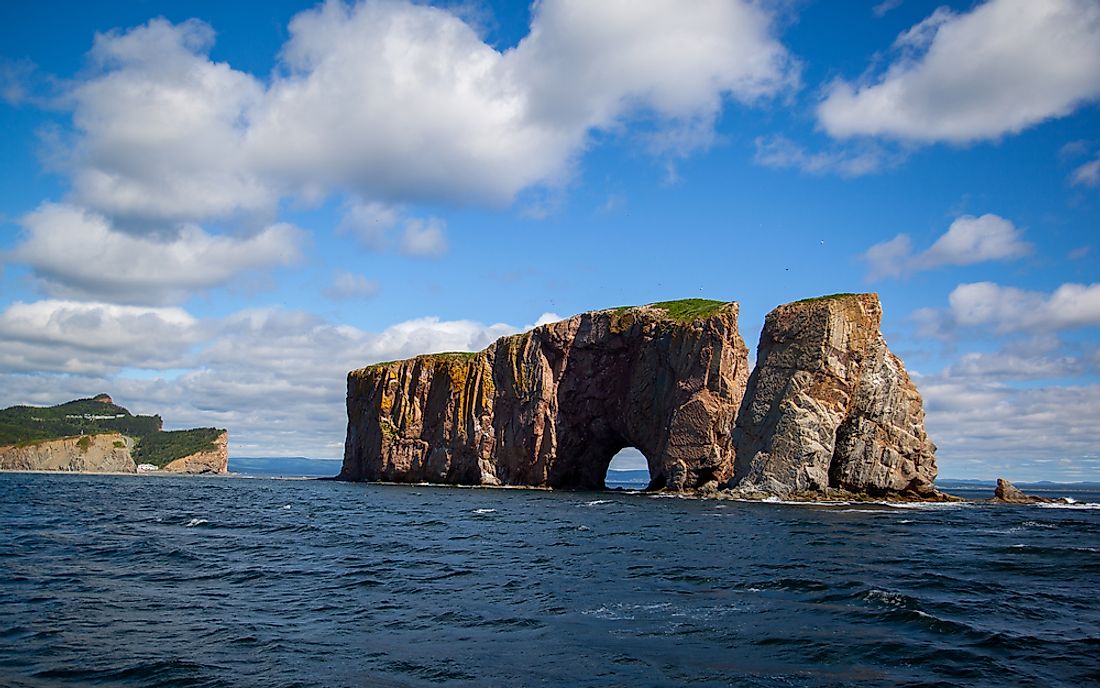What is Unique About Percé Rock?

Perce Rock is an imposing monolithic high rising rock from the sea and an amazing sight that has perplexed and inspired thousands of people throughout the ages. It is one of the largest arches over water in the world and is regarded as both a geographical and historical icon. Located in the Gulf of Saint Lawrence in Quebec, Canada, the rock formation is named after the pierced hole in its structure. From a distance, Perce Rock appears like a sailing ship. The rock formation is a major tourist attraction in the region of Gaspesie.
Naming of the Rock
The magnificent rock cliff is known by several names including Rocher Perce, Pierced Island or Rock, Perce Rock, and Split Rock. The name Perce Rock is the commonly used and is attributed to the pierced rock that forms a 49-foot high arch on the seaward southern end. The arch formed as if something like a needle had passed through the rock. The rock cliff was named Perce in 1607 by Samuel De Champlain. He first saw the rock in 1603 while navigating the Gulf of Saint Lawrence. Champlain is also the founder of Quebec City.
Geography and Description
The rock cliff is part of a range of cliffs, hills, and bays on the southwestern portion of Mal Bay. The features on this bay are formed of reddish-golden limestone and shale. Perce Rock has linked to the mainland a sandbar at low tides. Between the rock and the High Head is the Perce Bay with Perce Town located on the shores of the bay. To the southwest of Perce Rock is a cliff, approximately 0.5 miles from the shore. Next To the rock cliff is the Bonaventure Island which together they form Bonaventure Island and Perce Rock National Park. The park was founded in 1985 and has an area of approximately 2.2 square miles. Perce Rock is one of the five geological formations at the tip of Gaspe Peninsula.
At low tide, Perce Rock can be approached on foot while a boat can comfortably pass through the arch. The rock formation has steep faces on all sides and is approximately 0.7 miles in length and 300 feet in breadth. At its highest point, it rises to 289 feet and weighs approximately 5 million tonnes. It can generally be described as a narrow bluff emerging out of the water, resembling a bleached supertanker from some angles. Its limestone formation dates back to the Devonian period, over 400 million years ago. The ongoing erosion of the sea is slowly “eating away” the rock with geologists predicting that it will be completely eroded in the next 15,000-16,000 years.
Legend of Perce Rock
According to local legend, Perce Rock is a monstrous giant. A handsome young French Army officer Raymond de Nerac fell in love with a girl named Blanche and the two got engaged. Later, Raymond, against his wish, was posted to Quebec. Because of her love for the army officer, Blanche traveled to Quebec to marry him. On her way, her ship was attacked by the Spanish pirates and she was taken to the pirate captain who proposed to marry her. However, she jumped off the ship before she could be married. The following day, the pirates woke up only to find a huge rock floating near their ship. The rock resembled a floating ship.











